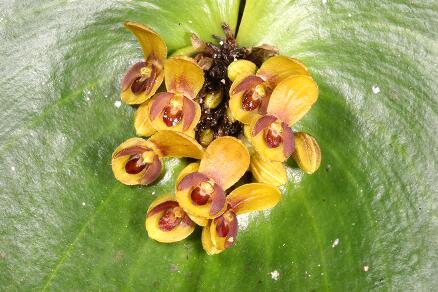Orchidaceae
Pleurothallis

Kingdom: Plantae Rank: Genus Parent: Orchidaceae Status: Valid
Morphological Description
Diagnosis: ##
Vegetative Morphology
Habit: Extremely diverse epiphytes, lithophytes, and terrestrials. Rhizomes short to creeping-trailing.
Main axis: Ramicauls (= secondary stems) short to elongate, usually slender, terete to compressed or angled, variably subtended and concealed by tubular bracts.
Leaves: Leaves one per ramicaul, highly variable in shape, sessile or petiolate, usually leathery.
Reproductive Morphology
Inflorescence: Inflorescences terminal at the apex of the ramicauls, sessile and fasciculate to long-pedunculate, subtended by a spathe, successively- or simultaneously-flowered, the floral bracts inconspicuous.
Flowers: Flowers one to many, fragrant to odorless, highly variable in color. Sepals free or the lateral sepals variously fused, subsimilar to strongly dissimilar, petals free, usually smaller than the sepals. Lip unlobed or three-lobed, sessile or clawed; callus absent, a basal depression, or variously ornamented keels. Column short and transverse to elongate, often club-shaped, +/- foot and wings, the clinandrium often ornamented; pollinia 2, naked.
Other
Notes:
Recent DNA studies as well as reinterpretation of floral morphology have led to a massive breakup of Pleurothallis in the broad traditional sense. Unfortunately, the authors of recent classifications are at odds and now agreed upon treatment has emerged. Thus a conservative approach is taken here following Schweinfurth’s Orchids of Peru.
Many species here are described as epiphytes, largely because the frequency at which they occur as terrestrials or lithophytes as well has not been recorded.